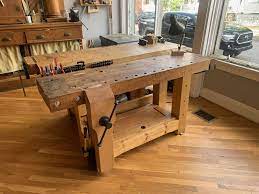
Here are reviews of Roubo Workbench. A Roubo workbench traces its origins to André Jacob Roubo, a French woodworking master from the late 18th century.
These workbenches are renowned for their heavy and robust construction, providing a stable and reliable work surface for various woodworking tasks. Why you should use one?
Key Features of the Roubo Workbench.
- Massive Size: Roubo workbenches are substantial, with a generous work area.
- Blocky Legs: The legs are flush with the front edge of the benchtop, ensuring stability.
- Leg Vise: A centuries-old style with a massive jaw, offering superb clamping pressure and ample space for workpieces.
Pros of the Roubo Workbench.
- Stability: Roubo benches are rock-solid, ideal for hand-tool work.
- Versatility: They excel at holding different types of work.
- Leg Vise: The leg vise provides exceptional clamping power and accommodates large workpieces.
- Traditional Aesthetics: Many woodworkers appreciate the classic design.
Cons of the Roubo Workbench.
- Construction Complexity: Building a Roubo bench can be challenging due to its laminated construction.
- Heavy: The weight can be both an advantage (stability) and a drawback (moving it around).
- Cost: High-quality materials and vises can make it expensive.
- Laminations: Some purists dislike laminated construction.
Reviews of the Roubo Workbench.
- Fine Woodworking featured a modified Roubo bench with BenchCrafted vises. The author praised the BenchCrafted leg vise and wagon vise for their secure hold and ease of adjustment. The full-size bench became the author’s favourite.
- A woodworker’s retrospective on a Petit Roubo bench highlighted its simplicity, stability, and use of oak. Drawbored joints added strength.
a Roubo workbench is a robust choice for serious woodworkers. Consider your preferences, budget, and woodworking style when deciding whether it’s the right fit for you.
Do you have any tips for building a Roubo bench?
Building a Roubo workbench is a rewarding project, but it requires attention to detail.
Here are some tips to guide you:
- Materials Selection:
- Hardwood: Choose dense hardwoods like beech, maple, or oak for durability.
- Laminations: Roubo benches often have laminated tops. Glue up several boards to create a thick, stable surface.
- Vises: Invest in quality vises (leg vise and wagon vise) for efficient clamping.
- Dimensions:
- Length and Width: Aim for a benchtop around 6 to 8 feet long and 24 to 30 inches wide.
- Thickness: A 3- to 4-inch thick top provides stability.
- Joinery and Construction:
- Mortise-and-Tenon Joints: Use these for the base frame.
- Drawboring: Offset the tenons slightly and drill through them for added strength.
- Bench Dogs: Drill holes in the top for bench dogs to secure workpieces.
- Vise Installation:
- Leg Vise: Install the leg vise on the front left corner. Ensure smooth operation and a sturdy jaw.
- Wagon Vise: Mount the wagon vise on the front right corner. It slides along the benchtop for versatile clamping.
- Stabilization and Leveling:
- Stability: Make sure the bench doesn’t wobble. Shim legs if needed.
- Levelling: Use adjustable feet or shims to level the benchtop.
- Finish:
- Oil or Wax: Apply a protective finish to the wood. Mineral oil or beeswax works well.
Remember, patience and precision are key. Take your time, and enjoy the process of creating a workbench that will serve you for years to come!
What tools do I need for building a Roubo bench?
Building a Roubo workbench is an exciting project for any woodworker. To create this sturdy and versatile bench, you’ll need the following tools and materials:
- Materials:
- Hardwood: Choose heavy-duty wood such as oak or maple for the legs and stretchers.
- Sturdy Hardware: Lag bolts and washers for assembly.
- Essential Tools:
- Saw: Use a saw to cut the wood to the desired size.
- Drill: Make holes for bolts and other hardware.
- Clamps: Hold pieces together during assembly.
Patience and precision are key when building your Roubo workbench.
How do I choose the right hardwood for my Roubo bench?
When selecting hardwood for your Roubo workbench, consider the following factors:
- Species Choice:
- Native Hardwoods: Any native hardwood will suffice for the benchtop. However, consider using a lamination of thinner strips turned to expose the edge grain.
- Dense Species: If you do a lot of hand planning, opt for denser species. They provide better stability and wear resistance.
- Flatsawn vs. Edge Grain:
- Edge Grain: For the benchtop, consider using edge grain by laminating thinner strips. This enhances stability and minimizes warping.
- Base Material:
- The base can be made from any species at hand. Choose what’s readily available and suits your preferences.
A well-chosen hardwood will contribute to the longevity and functionality of your Roubo workbench.
What are the advantages of using edge grain for the benchtop?
Using edge grain for the benchtop of your Roubo workbench offers several advantages:
- Stability: Edge grain laminations create a stable surface that resists warping and movement. This is crucial for a workbench where precision matters.
- Wear Resistance: The long-grain fibres in the edge grain provide excellent wear resistance. As you work on your bench, it will withstand the rigours of sawing, planing, and chiselling.
- Visual Appeal: Edge grain showcases the natural beauty of the wood. The alternating lines create an attractive pattern that many woodworkers appreciate.
- Easier Glue-Up: Laminating thinner strips of edge grain is easier than working with wide boards. It allows you to create a thick top without relying on massive single pieces.
Remember, edge grain is a smart choice for your Roubo benchtop, combining functionality and aesthetics.

